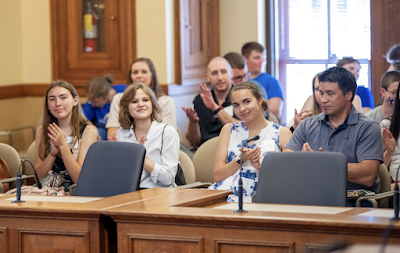 |
Election workers inspect ballots for machine readability.
(Photo by Dan Pelle, The Spokesman-Review) |
No one should face death threats for doing their job, but over the past four years, that's what many U.S. election officials have suffered, and now states are working to address the problem while facing a shortage of election workers. "After the 2020 U.S. presidential election, election officials faced unprecedented threats to their safety and security,"
reports Saige Draiger for the
National Conference of State Legislatures. "Since 2020, state policymakers from both parties have confronted the harassment of election workers, including threats of violence, from a variety of angles, including by revising existing statutes and passing stand-alone protections. . . . . Now, after years of attacks, the profession is facing a new challenge: the loss of seasoned election administrators ahead of the 2024 general election."
In 2016, election jobs were
described as "boring but important work." Now it can still be tedious, but has the added stress of being possibly dangerous. "A
2022 nationwide survey of local election officials showed that nearly a quarter of them experienced threats of violence, harassment or other instances of abuse as the result of their work," Draiger writes. "A separate
survey of local election officials conducted in early 2023 estimates that nearly 1 in 5 officials serving in 2024 will be new in their role."
U.S. Election Assistance Commission member Donald Palmer, told Draiger: "With the increased negative environment, election administrators are retiring early or leaving the profession, and the election community loses the core of its qualified and experienced officials. . . . The election official departures are an acute state public-service problem."
For the 2024 election cycle, states governments have four huge tasks: making election jobs as safe as possible, shoring up staff shortages, supporting experienced staff, and finding ways to cover increased costs. Neal Kelley, a retired registrar who chairs the
Committee for Safe and Secure Elections, told Draiger, "Although 2022 was generally positive, the embers of 2020 continue to smolder, and there is evidence to show that threats against public officials are a problem that is not slowing down. . . . While CSSE does not take positions on specific legislation, our committee has worked with members of state legislatures nationwide to focus efforts on protecting election officials' privacy, increasing penalties for threats, enhancing physical security and finding creative ways to increase funding."
States have several options to protect workers, including "updating who is covered by state address-confidentiality programs, which shield from public access the voter-registration information of people at risk of harm because of who they are or what they do for work," Draiger reports. "States are also revising their statutes to criminalize threats against election workers. In 2021,
Arizona and
Kansas made it illegal to impersonate an election official.
Washington enhanced criminal penalties for harassment of election workers, placing them in the same protected category as judicial workers. . . . Colorado and Maine went further, enacting laws with additional fixtures."
Election Assistance Commissioner Ben Hovland told Draiger, "This is not just a swing-state issue or a red-state, blue-state issue. Unfortunately, election officials all over the country have received threats and harassment against themselves, their families and their children. Protecting election officials is critical to the functioning of our democracy. State and local officials must feel safe doing their work, and state legislators can take significant steps to help."
























